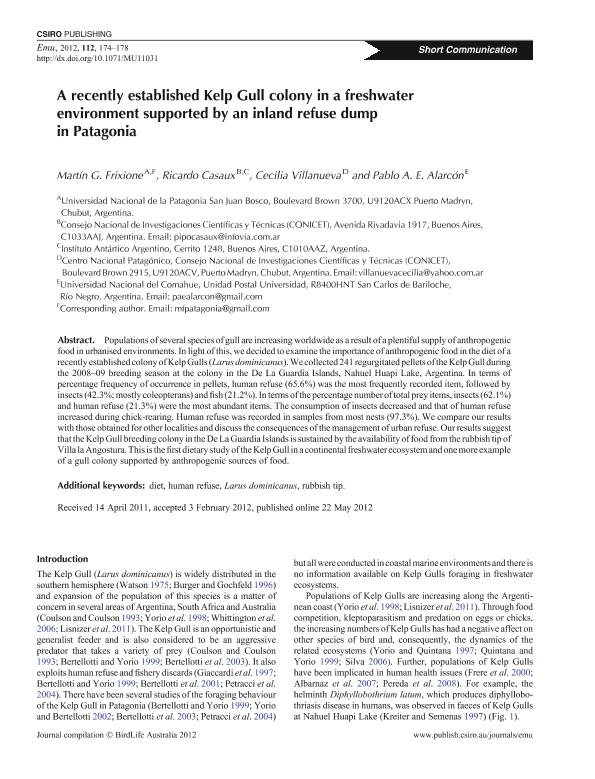Artículo
A recently established Kelp Gull colony in a freshwater environment supported by an inland refuse dump in Patagonia
Frixione, Martín G.; Casaux, Ricardo Jorge ; Villanueva, María Cecilia
; Villanueva, María Cecilia ; Alarcón, Pablo Angel Eduardo
; Alarcón, Pablo Angel Eduardo
 ; Villanueva, María Cecilia
; Villanueva, María Cecilia ; Alarcón, Pablo Angel Eduardo
; Alarcón, Pablo Angel Eduardo
Fecha de publicación:
05/2012
Editorial:
Csiro Publishing
Revista:
Emu
ISSN:
0158-4197
Idioma:
Inglés
Tipo de recurso:
Artículo publicado
Clasificación temática:
Resumen
Populations of several species of gull are increasing worldwide as a result of a plentiful supply of anthropogenic food in urbanised environments. In light of this, we decided to examine the importance of anthropogenic food in the diet of a recently established colony of Kelp Gulls (Larus dominicanus). We collected 241 regurgitated pellets of the Kelp Gull during the 2008-09 breeding season at the colony in the De La Guardia Islands, Nahuel Huapi Lake, Argentina. In terms of percentage frequency of occurrence in pellets, human refuse (65.6%) was the most frequently recorded item, followed by insects (42.3%; mostly coleopterans) and fish (21.2%). In terms of the percentage number of total prey items, insects (62.1%) and human refuse (21.3%) were the most abundant items. The consumption of insects decreased and that of human refuse increased during chick-rearing. Human refuse was recorded in samples from most nests (97.3%). We compare our results with those obtained for other localities and discuss the consequences of the management of urban refuse. Our results suggest that the Kelp Gull breeding colony in the De La Guardia Islands is sustained by the availability of food from the rubbish tip of Villa la Angostura. This is the first dietary study of the Kelp Gull in a continental freshwater ecosystem and one more example of a gull colony supported by anthropogenic sources of food.
Palabras clave:
Diet
,
Human Refuse
,
Larus Dominicanus
,
Rubbish Tip
Archivos asociados
Licencia
Identificadores
Colecciones
Articulos(CCT-CENPAT)
Articulos de CTRO.CIENTIFICO TECNOL.CONICET - CENPAT
Articulos de CTRO.CIENTIFICO TECNOL.CONICET - CENPAT
Articulos(INIBIOMA)
Articulos de INST. DE INVEST.EN BIODIVERSIDAD Y MEDIOAMBIENTE
Articulos de INST. DE INVEST.EN BIODIVERSIDAD Y MEDIOAMBIENTE
Articulos(SEDE CENTRAL)
Articulos de SEDE CENTRAL
Articulos de SEDE CENTRAL
Citación
Frixione, Martín G.; Casaux, Ricardo Jorge; Villanueva, María Cecilia; Alarcón, Pablo Angel Eduardo; A recently established Kelp Gull colony in a freshwater environment supported by an inland refuse dump in Patagonia; Csiro Publishing; Emu; 112; 2; 5-2012; 174-178
Compartir
Altmétricas



